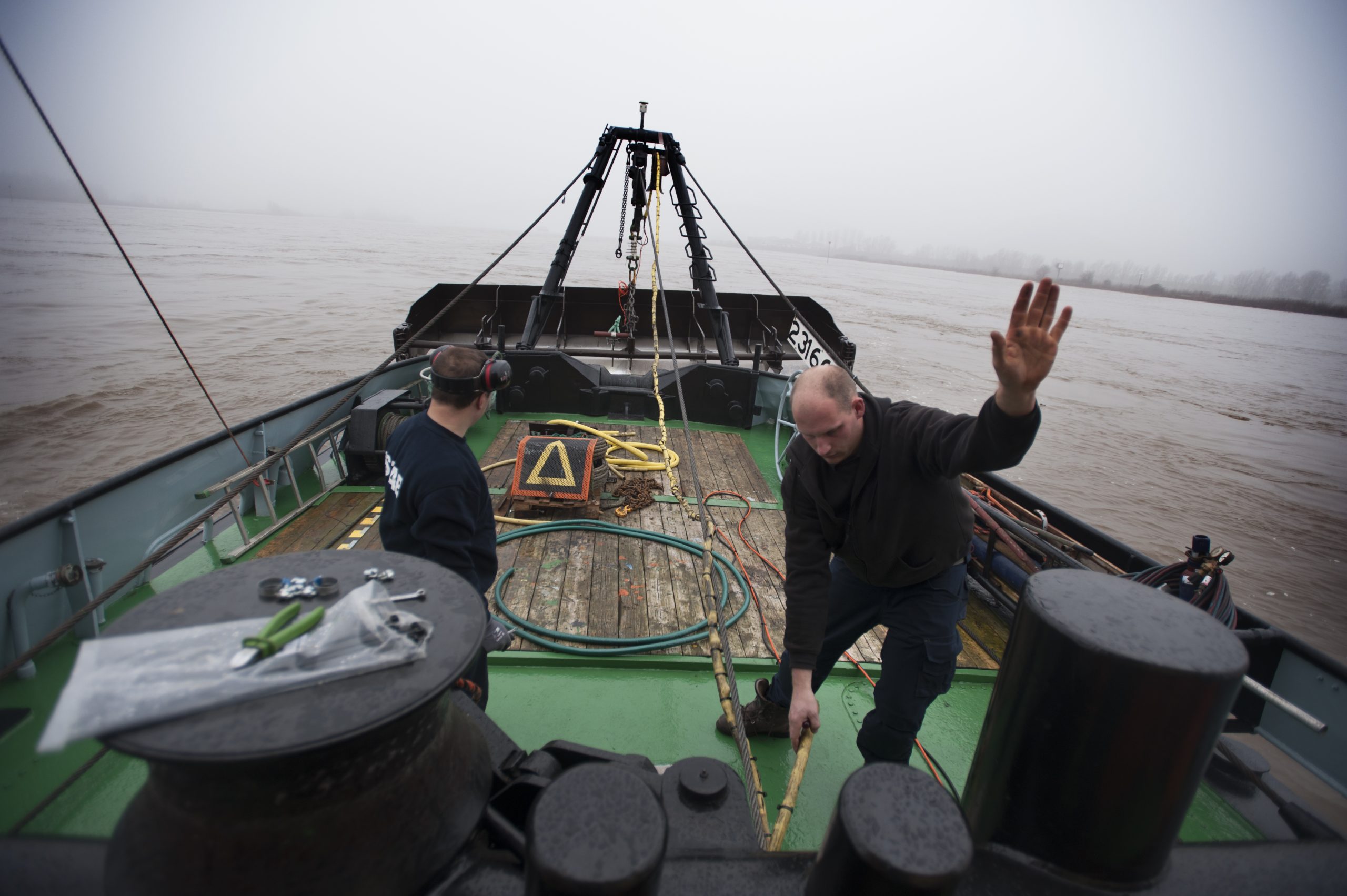The shipping channel of the river the Waal is at risk of becoming clogged. Delft researchers are helping to keep the most important river transportation route through The Netherlands navigable.
Dredging boat Dintel keeps a safe course alongside the summer dyke. Its captain, Joop van de Hoeff, is on his way to a new dredging location. He has the tough task of keeping the shipping lane navigable whilst keeping out of harm’s way. As the main distributary branch of river Rhine, the Waal river plays an important role in inland navigation. Large ships loom from out of the fog and pass closely, one after the other.
Dangling behind the Dintel from a crane is a new kind of plough developed by Delft researchers in collaboration with the research institute Deltares. It actually looks more like a very broad scoop with an openable bottom and backside. The hope is that this simple device will ultimately allow Dintel to work twice as efficiently.
Dintel is one of two dredging ships working continuously in the Waal. It works together with a trailing suction hopper dredger which makes gullies at places in the riverbed where too much sand has accumulated. Dintel subsequently rakes the area, removing any trace of the river dunes that have formed under water.
Rijkswaterstaat, the governmental body responsible for the rivers, prefers not to add any more dredgers on the river in order to limit the nuisance to shipping.
But Dintels lone job is getting tougher. The amount of sand it removes is already about 150 thousand cubic meters a year, mostly in the area called Midden Waal near its boarding place Tiel. That is estimated to increase, possibly ten to forty percent. So the boat will need to work more efficiently.
Partially submerged floodplains behind the summer dyke are reason for the increase in sedimentation and can been seen on the starboard side of the ship. In 2007, the Dutch government started taking different measures to increase the water storing capacity of the Dutch river systems. The so called ‘room for the river’ program, which is set to end in 2015, entailed the relocation of dikes, the excavation of flood plains and the lowering of groins. As a side effect of these measures, the currents in the shipping channel have decreased, which in turn causes more sediments to precipitate. Underwater river dunes are forming at increased speed.
Masters student Tim van der Lugt (CEG faculty) has been dredging with the new type of plough for several weeks now. It is based on an idea which resulted from an MSc-study of his predecessor, Ir. Hein Bots, a few years ago.
Van der Lugt explains what he and his supervisor Dr. Ir. Arnold Talmon (MMME faculty, section offshore and dredging engineering), who also came a board the ship today, are testing. “Normally an open rectangular steel construction is dragged behind the boat,” he says. “Dragging this over the river bottom costs a lot of energy because of the high internal friction between the sand grains. By closing the bottom of the plough by a steel flap, as we did, we reduce the resistance since the friction between steel and sand is a lot less. When the plough has reached a deeper area the heap of sand is released by lowering the steel flap.”
As it stands now, however, this new plough isn’t an improvement. Van der Lugt hasn’t got the exact numbers at hand as he still needs to analyze all his measurements, but it is clear that the plough is much too heavy to compensate for the reduced friction between sand and steel.
Also, some adjustments need to be made to the design. “One day,” Van der Lugt says, “while we were doing a measurement the plough didn’t open to release the sand on time. At that moment the strain on the ship was the equivalent of 25 thousand kilograms. That is two and a half times the amount this ship is built for. The whole backside of the ship disappeared under water. It was scary.”
With Van der Lugt’s research coming to an end, Talmon is looking for another student to continue where Van der Lugt has left off and rake the De Waal’s bottom with ever more efficiency.



Comments are closed.